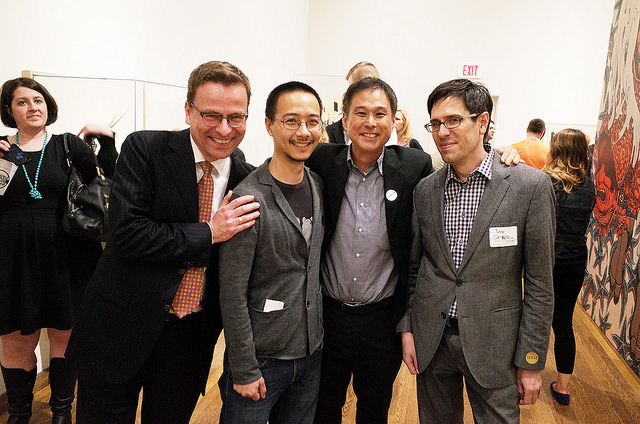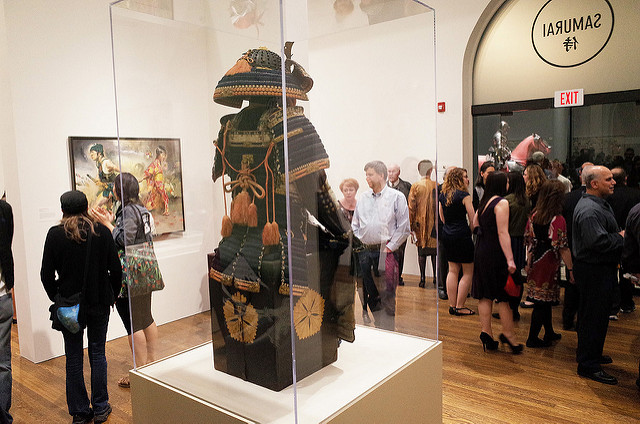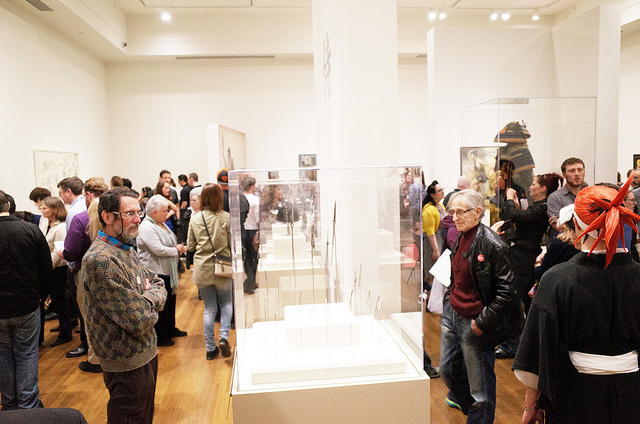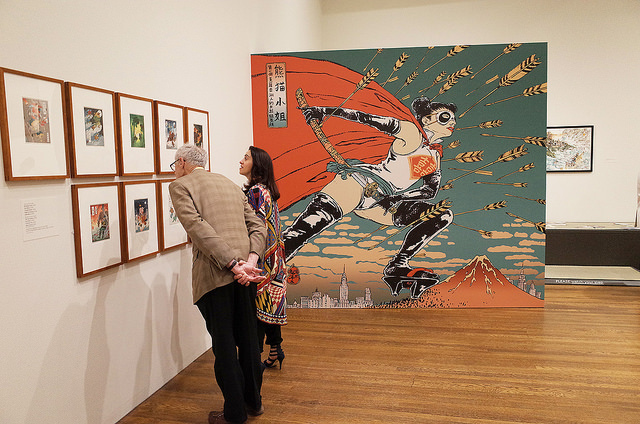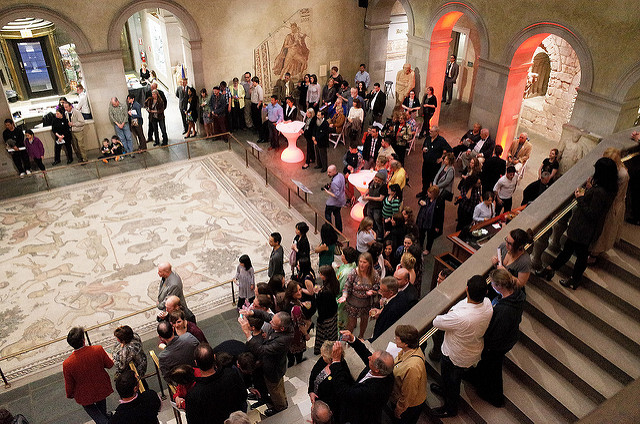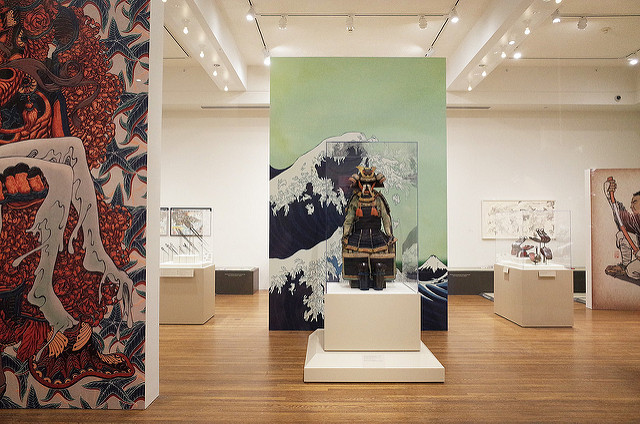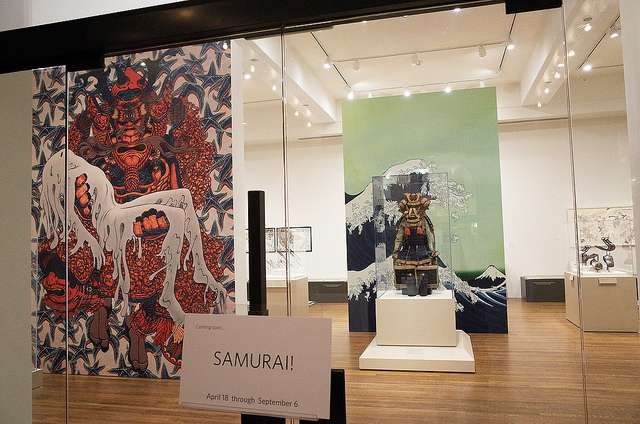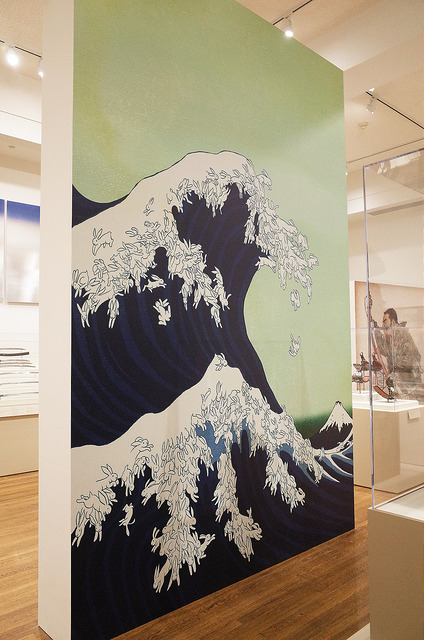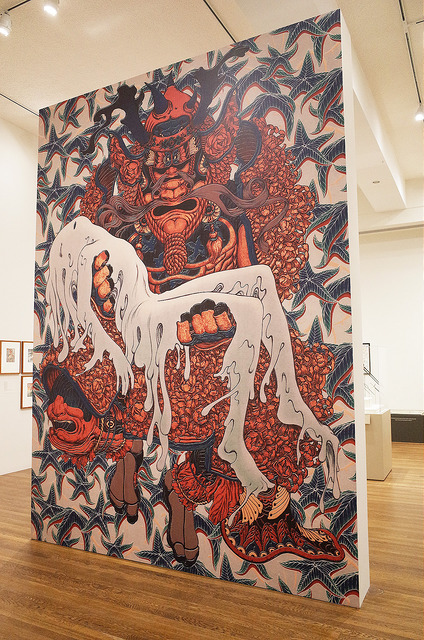Worcester Art Museum in Worcester, Massachusetts posseses the second largest armor collection in the United States. A samurai armor exhibition was on schedule, yet rather than exhibit the armor traditionally, the museum was willing to allow me to display the chosen pieces with contemporary art. Alongside armor, stirrups, arrows, and swords, were paintings echoing select objects. The exhibition was displayed in a manner where a viewer could observe a historical piece and transpose it with a viewpoint of a recent work. The second phase of the exhibition included murals painted in the lobby by Andrew Hem, Audrey Kawasaki, and Mari Inukai.
Worcester Art Museum
Contemporary Artists Explore Samurai in Popular Culture With New Exhibition and Mural Installations at WAM
16th – 19th Cent. Japanese Martial Objects Presented in Dialogue with Artworks to Illuminate Mythic Connotations of Samurai Today
Worcester, MA – March 10, 2015 – This spring, the Worcester Art Museum (WAM) will feature a diverse array of artistic interpretations of samurai in contemporary culture. On view April 18 through September 6, 2015, Samurai! draws inspiration from the recently-acquired Japanese arms and armor in the John Woodman Higgins Collection to examine contemporary perceptions of this centuries-old tradition. Spanning a variety of media, from painting, and drawings, to paper sculpture and digital and woodblock prints, the exhibition spotlights recent works by Japanese and American artists and illustrators, among them Miya Ando, James Jean, kozyndan, Mu Pan, Ferris Plock, Masakatsu Sashie, Rob Sato, Yuko Shimizu, and Kent Williams. Their works will be interspersed with finely crafted samurai objects from the 1500s–1800s as a historic counterpoint to the fantastical depictions of samurai found throughout the galleries.
From May 4 through May 9, 2015, visitors will also have the opportunity to witness the installation of site-specific murals being created for the exhibition by artists Andrew Hem, Audrey Kawasaki, and Mari Inukai. These large-scale paintings will also draw on themes and symbols related to samurai and will extend the exhibition into other areas of the Museum.
“As we continue to integrate the Higgins collection into our own, we are creating transformative spaces within the Museum that immerse visitors in ideas emanating from a distant time period but continue to feed the imaginations of today’s most creative minds,” said WAM Director Matthias Waschek. “With the opening of Samurai!, the Museum encourages viewers to draw connections between fine art and popular culture, while sparking a dialogue on how western perceptions of eastern customs are manifested through these mediums.”
Highlights from the exhibition include:
The Loyal 47 Ronin (2011) by Mu Pan is characteristic of the artist’s blending of historical and popular culture. In this work, Pan renders the legendary band of rōnin (a samurai with no lord or master) defeating Godzilla in his own contemporary illustrative painting style that references the Ukiyo-e Japanese tradition.
Recent work by San-Francisco-based artist Ferris Plock draws on the artist’s childhood experience growing-up a block from a Buddhist temple. Often using golden backgrounds, Plock painstakingly creates intricate patterns in the attire (from yukata to samurai armor) of his subjects which are often animals or ball-cap sporting traditional Japanese Ukiyo-e faces.
Mother and Daughter (2009) by Kent Williams showcases the artist’s expressionist approach to painting in his depiction of a mother and daughter wearing traditional samurai armor, a contemporary departure from the traditional approach of showcasing men as samurai.
As a complement to the contemporary works on view, Samurai! reveals the craftsmanship and highly skilled metalwork applied to the creation of historic Japanese arms and armor. From a complex armor suit from Japan’s Edo period crafted from thousands of strips of lacquered leather assembled with colorful silk laces, to a 19th-century sword-guard adorned with a lonely deer bellowing at the autumn moon, the objects on view are embedded with a rich variety of embellishments that express Japanese values and are representative of the owner’s persona.
This historic material speaks to the evolution of samurai during the Tokugawa era from military warriors to bureaucrats, administrators, and other government officials. Lasting from 1603 to 1868, this period of peace in Japan diminished samurai’s military function and transformed their swords into symbols of power rather than weapons intended to inflict harm. The Tokugawa era also brought about a shift from creating tools of warfare towards decorative objects for samurai. Examples of these works will be on view in the exhibition, including a fully-articulated lobster and dragon (1850–1900), which have been fully conserved by the Museum to reveal the objects’ finely crafted metalwork.
“Samurai! has been a highly collaborative process with the Museum’s curatorial, education, and conservation departments,” said guest curator Eric Nakamura, founder of the Los Angeles-based Giant Robot Store and GR2 Gallery. “I am used to working with contemporary artists and illustrators, but looking at historical materials through a contemporary lens has produced truly unique work. A number of surprising parallels can be made—both time periods have flourishing art production, including work in traditional media but also unexpected places, from armor of the past to the streets of the present. As someone at the intersection of Asian and Asian American popular culture, it’s rewarding to introduce visitors to Japanese customs and contemporary art simultaneously.”
A special installation in Helmutt’s House will invite family participation and introduce visitors to the world of Usagi Yojimbo, Stan Sakai’s renowned comic book series featuring a rabbit rōnin. Taking place at the beginning of the Edo period, Usagi Yojimbo is largely influenced by Japanese history, folklore, and cinema, including the work of Akira Kurosawa, another figure greatly influenced by the samurai legacy. Funding for Samurai! has been provided in part by a generous grant from the E. Rhodes and Leona B. Carpenter Foundation and with sponsorship support from United Bank Foundation Massachusetts.
Select Press

